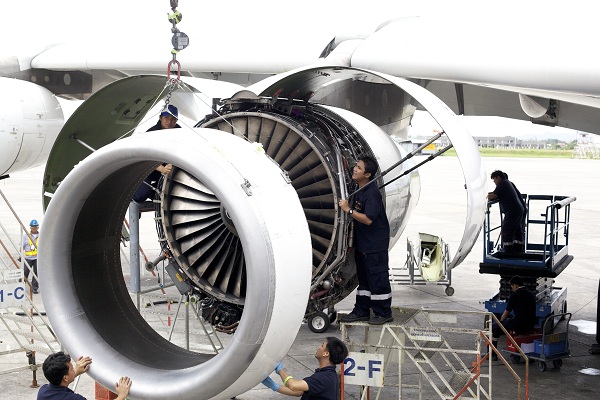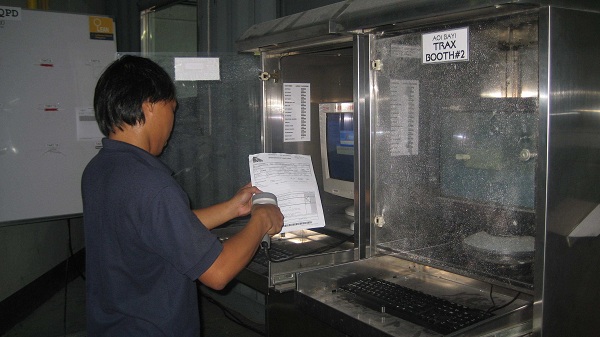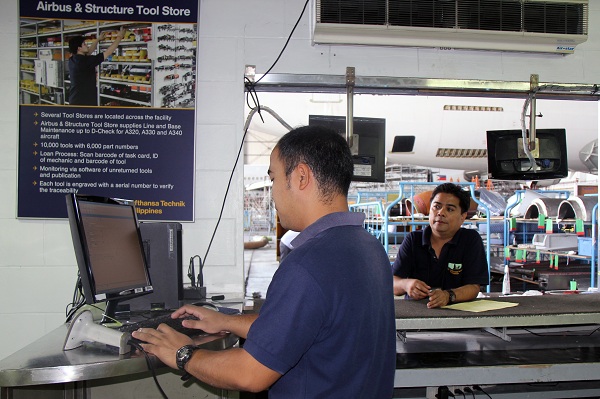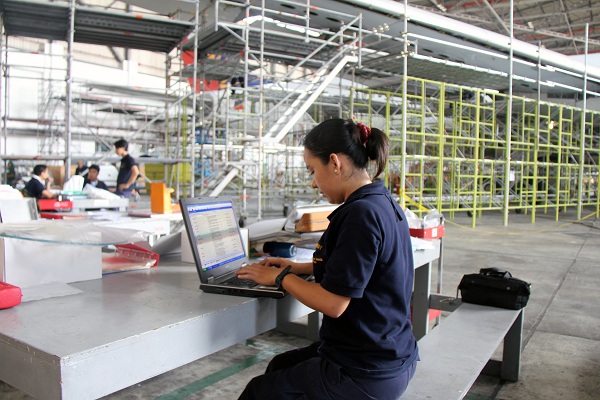Articles
| Name | Author | |
|---|---|---|
| Case Study: Power Play and the consequences of equipment upgrades and overhauls | Karl Jones, Head of Avionics and Technology Development, Marshall Aerospace Ltd | View article |
| White Paper: A Discussion on Project Management | Wes Parfitt, CEO and Founder, EnvelopeAPM Inc. | View article |
| White Paper: An Inconvenient Truth: CMS.. | Thanos Kaponeridis, President and CEO, AeroSoft Systems | View article |
| White Paper: Life is Dynamic: Business must operate dynamically too | Michael Wm. Denis, Principal, ICF SH&E | View article |
| Case Study: Challenges in capturing man-hours and materials consumed in airframe checks | Dr. Roberto M. Asuncion, VP-IT, Lufthansa Technik Philippines | View article |
Case Study: Challenges in capturing man-hours and materials consumed in airframe checks
Author: Dr. Roberto M. Asuncion, VP-IT, Lufthansa Technik Philippines
SubscribeChallenges in capturing man-hours and materials consumed in airframe checks
Dr. Roberto M. Asuncion, VP-IT, Lufthansa Technik Philippines outlines an analysis of the practicalities and benefits of IT systems in the MRO process.
Rapid turnaround times (TAT) and efficient materials management are both critical factors in a successful MRO event. It is, therefore, important that the correct man-hours worked and the actual amount of materials consumed during a layover are accurately recorded and reported.
The ability of a cost sensitive service organization to translate work done into hours charged can still be a daunting challenge, even in this technology driven age. But, both client and service provider need to know, with a high degree of accuracy and confidence, the actual time spent by the workforce on specific tasks and quantities of materials consumed from commencement to the completion of the contracted event. Accurately reported time and material charges are synonymous with quality operations; the transparency of the reports enhances confidence in the organization handling the check thereby improving customer relations.
A combination of efficient processes, a disciplined workforce and flexible IT systems will ensure the commercial and operational success of an MRO check. This could be further enhanced by integrating Lean practices not only in production but also in IT.

Figure 1. Mechanics from Lufthansa Technik Philippines (LTP) service an aircraft just outside the main hangar in Manila
The Challenges
Accurately measuring the total time taken to complete an event remains a highly process driven and human influenced activity. From simple turn-around checks to the more extensive D- and IL-checks, the accuracy of time-stamped data is very important in determining the commercial and operational success of a contracted event.
Materials availability and consumption needs also to be closely monitored during a layover. If the required parts are not available on time, it not only delays the release of an aircraft it can also increase the cost of the layover when materials and parts consumption is not properly controlled.
Capturing Man-hours Data
At first sight, the process of capturing man-hours data seems a simple enough matter: book on at the start of a task, perform the task, and then book off at the end of the task. However, simple as it may seem, computer systems and personnel related issues can severely limit the accuracy of man-hours capture.
Prior to automation, work orders and task cards had to be encoded manually into the system to book on or book off a specific task. In modern MRO systems, the reference numbers of work orders and task cards are barcoded. These barcodes are scanned by mechanics immediately at the start and at the completion of the work, substantially reducing encoding errors and speeding up the documentation process.
Although more automated features have been introduced, e.g. use of smartcards and card proximity readers, the inability of mechanics to properly book their actual man-hours remains a major problem. Accessibility and reliability of the clocking devices in the production area is also an important consideration in improving the accuracy of man-hour capture.
In many instances, a failure to book on at the start or book off at the end of the shift, is falsely recognized by the MRO system as overtime work (or as an extended shift) which is reflected as an unusually high number of man-hours charged for a task. This, in turn, introduces wrong data into the system and, in a tightly coupled system, the error propagates easily, compromising the integrity of the whole database.
Tracking Materials Consumption
An aircraft check involves many stages entailing the withdrawal and consumption of materials. The location and tracking of materials, their ownership status, and associated costs are significant concerns for this aspect of an MRO operation.
For an operation that deals exclusively with a single airline, the tracking issue can be relatively simple. However, as the number of airlines dealt with increases, the operation grows in complexity, such as in the case of third party MRO providers. Because of their different operating models and layover requirements, the challenge becomes even greater when simultaneously servicing aircraft from both legacy airlines and low cost carriers.
One problem can arise when a common part owned by one airline customer might inadvertently be issued out to service another airline’s aircraft of the same type. The system may be able to prompt the store keeper that a specific part is owned by a different airline customer but it may not be able to prevent it from being physically issued out. As more airline customers have more of their owned parts stored in the service provider’s warehouse, segregating those parts in logical locations based on ownership of each part complicates the monitoring and ordering tasks for stores staff and mechanics.
Materials consumption can also be regulated by setting thresholds. These thresholds vary depending on the agreement between the MRO provider and the customer. In this case, the approval of a customer is needed for consumption beyond the agreed limit; a mechanism that is supposed to promote the efficient use of materials and limit disputes.
In some cases, provisioning for materials needed during a layover is the responsibility of the customer and not the third party MRO provider, e.g. customer supplied materials (CSM) or buyer-furnished equipment (BFE). These materials must also be tracked during the layover.

Man-hours and materials consumption data are linked together in the MRO system when an aircraft is being serviced.
Regulatory compliance also needs to be considered, for example, in issuing parts manufacturer approved (PMA) materials. Some customers might not allow the installation of PMA parts during a layover while others will. Hence, more stringent monitoring of materials data is required in this situation.
Challenges on the IT system
Problems involving computer systems can be as complicated as personnel issues. Situations such as new applications not interfacing accurately with the MRO system, procedures not being followed by the users, system downtimes due to hardware malfunction or extended power outages are just some of the challenges faced by IT in ensuring that the whole system is running reliably and that data are being recorded accurately.
Some data inaccuracies may be introduced into the MRO system during the delivery and application of a regular software patch or a version upgrade. During the installation of a service pack, a new error can inadvertently be introduced while attempting to correct a previously reported error. Issues in data accuracy can also result from data elements being altered, lost or moved within the database because of a version upgrade resulting in a slight change in the database schema. For large systems with a history of modifications and interfaces to other applications this situation can be very disruptive for the operations. Interfaces and other third-party applications that connect with the MRO system will have to be checked and, subsequently all the affected systems will have to be corrected. The longer these problems are left unresolved the greater are the risks that data will be lost or will not be accurately entered, in which case, there will have to be a tedious process of re-checking and validly entering corrected data into the system.
It is also possible that a new functionality might not exactly fit the current business processes. It is important to assess if any new system functionality introduces new and more efficient industry practices that can, in turn, raise productivity without incurring unreasonably high implementation costs or adding more complications to the current business processes. On the other hand, new business requirements requiring changes in business processes might not be supported by the current MRO system functionality. In this case, it is best to research to confirm whether the MRO system can be modified to fulfill the new requirement or if it would be more advantageous to have a separate application that will be linked to the MRO system.
The earlier these errors are detected and resolved, the better it will be in terms of limiting the magnitude of the errors to a manageable size. It is best to always thoroughly test any patch or upgrade before installing it into the production system.
Software issues are not the only problem. The reliability of infrastructure components such as networks, computers (desktops, notebooks and handhelds) and other peripheral devices like scanners, barcode readers and printers, can greatly affect the quality of captured data. Data accuracy is at risk whenever the system is inaccessible due to network and server downtimes.
Practical solutions
Many of the IT and business process solutions introduced in the company during the past eight years have made significant contributions towards improving the accuracy of reporting man-hours worked and materials consumed. Most of the business processes in LTP are supported by three major systems: the MRO System (Trax), the Financial System (SAP) and the company portal running on Microsoft’s Sharepoint platform. A majority of the specialized applications that interface with Trax are integrated in the portal.
Compliance in the booking process is a key requirement for getting an accurate man-hours report. Continuous improvements in the procedures, the system infrastructure and the MRO system together with its interfaces have resulted in improved compliance and, eventually, to more accurate man-hour reports. For example, the deployment of more reliable clocking devices, the availability of more wireless devices that can be used in the hangars and in airport terminals (including the upgrading of PCs together with training and access to specially-designed reporting tools) has improved the accuracy of man-hours data. Some production sections that were previously reporting man-hours data in the mid-90% are now registering consistent 98%-100% man-hour reporting compliance.

Figure 3. Capturing man-hours data.
A mechanic books-on his work in one of the wireless terminals inside the hangar. The work order, task card reference and start time are automatically logged into the system as he scans the barcoded information printed in the task card.
An MRO system cannot cater fully for all the company specific business requirements current at any given time. It is, therefore, typical to see some customized interfaces built around the MRO system. In LTP, a number of these interfaces deal with computations of actual man-hours reported based on various shift schedules and exceptions reporting on unreported man-hours and other outliers. Reporting of man-hours is available on the MRO system and is also interfaced in the company portal. These interfaces were programmed in-house and have been tested and approved by the users. A number of interfaces were developed to connect to the standard MRO system. These in-house programmed interfaces and applications address specific requirements of the business that are not found in the standard system. Having these small in-house applications avoids adding further complexities to the MRO system. It also makes it easier to isolate points of failure when implementing enhancements to the business processes.
One of these in-house tools is a materials request system available to mechanics on the production area and enabling them to withdraw materials based on the ownership of those materials. The materials planner/buyer also uses it to determine non-stock items. This is particularly helpful if aircraft from several different airlines are being serviced at the same time in the hangar. A materials tracking system is also available to the personnel in the production line to determine the location of materials at any stage of the layover.

Figure 4. A mechanic withdrawing materials using the MRO system.
A production planning system was also programmed to provide a complete 24/7 view of the maintenance work to be done including man-hours, work orders and materials requirements. This application is interfaced with the MRO system and is also available through the portal. It provides a global view of the work completed and to be undertaken at any given time on a ‘per aircraft’ basis.
LTP has installed both wired and wireless infrastructure inside the hangars, around the apron area and in several airport terminals in order to enable mechanics to use the MRO system, not just for clocking their tasks and ordering materials, but also to view aircraft maintenance manuals, send/receive emails, print related references etc. The wireless infrastructure has been extended to some of the airport terminal bay areas where line maintenance is carried out for several customer airlines.
Recently, several LTP vehicles were fitted with wireless devices in order to assist mechanics while working on the bridgeways and in airport parking bays. Aside from carrying the mechanics’ usual tools, these air-conditioned vehicles now have a laptop and printer which the mechanics can use. Both devices are powered through the vehicle’s electrical supply. The laptop connects wirelessly to the MRO server in the main LTP office in Manila, allowing the mechanic to work beside the aircraft wherever it is parked without the need to move back and forth between the aircraft and the terminal office to gain access to the computer systems. This facility is particularly useful when the terminal bays are full and the aircraft has to park at some distance from the offices.
As mobility becomes increasingly important to support the production operations, project teams are looking into more collaborative means of communication and more efficient computing devices, including the use of tablets and smartphones to augment the traditional PCs and laptops.

Figure 5. Extending the reach via WiFi. A mechanic working on her WiFi-enabled laptop where she can order materials during a layover.
Because of efficiency enhancements and more accurate reporting of, among other things, man-hours data and materials consumption data, additional revenues and increased cost savings have been achieved through better planning and scheduling of the workload, reduced wastage and better utilization of materials, and more accurate charging of actual man-hours worked on the aircraft during layover.
Moving on with Lean MRO and Lean IT
Many of the solutions above reflect LTP’s response to challenges that MROs face in providing quality service to customers. These solutions were achieved through the cooperation of several production and support teams. Finding a solution is one part of the challenge. Improving on the solution and creating a breakthrough process that changes and improves the way people work and do business is the more challenging next step.
Several years ago, LTP embarked on a Lean MRO program in order to make the production and support units more efficient in fulfilling the varying requirements and high expectations of its customers. It not only improved the way we capture man-hour and materials consumption data, but it also produced a number of process improvements that have reduced the TATs of several aircraft layovers, reduced waste in the production process and improved the quality of service delivered.
The IT department has also implemented a Lean IT program geared towards making the organization more agile and more responsive to the changing needs of the business while, at the same time, reducing IT costs. It has programmed several interfaces around the company’s Trax MRO system and has been continuously improving these interfaces to make the system simpler and more accessible to users through its web-based portal. The IT group not only provides 24/7 service desk for LTP’s internal users and customers, it also provides training and implementation services to other local and international organizations.
LTP continuously tries to find ways to improve its industry-standard business practices. At the time of writing, several project teams composed of users from the production, materials, IT and finance areas are engaged in finding more efficient ways to improve the accuracy of man-hours capture, and materials tracking and control. Continuous improvement not only raises the bar, it also brings about a positive change to the whole organization.
Comments (0)
There are currently no comments about this article.

To post a comment, please login or subscribe.